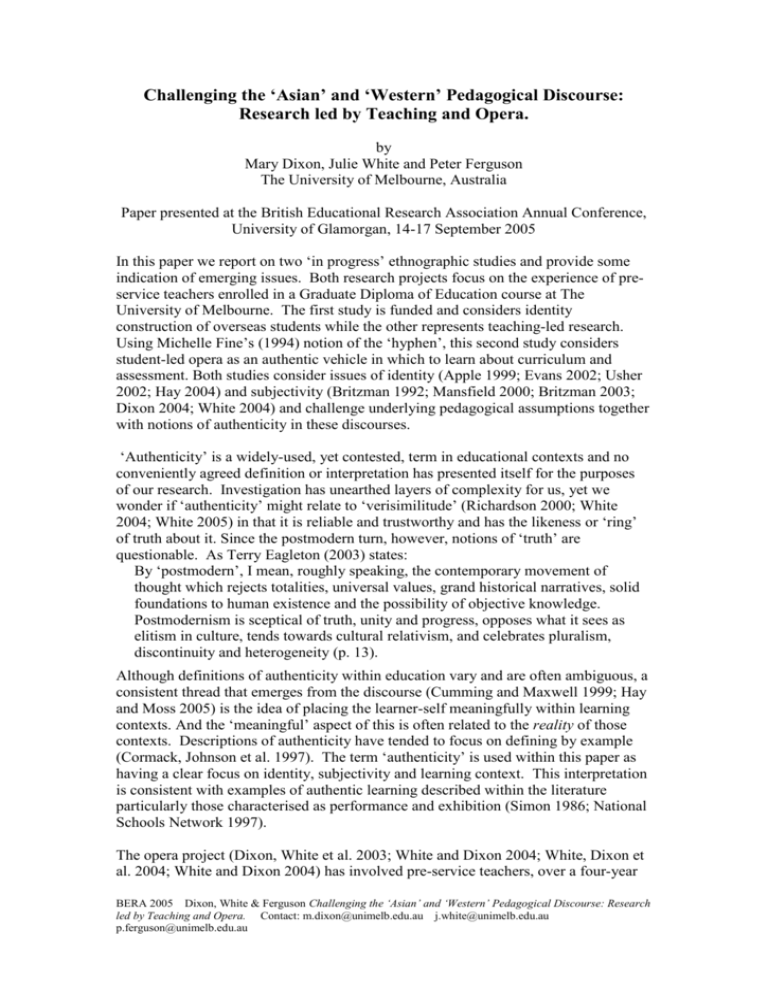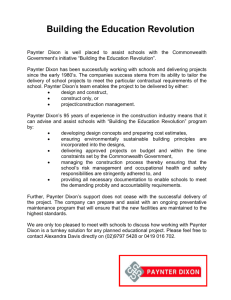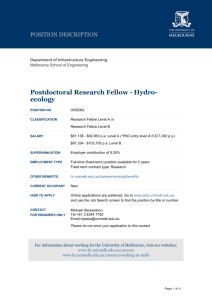Authenticity is a contested term in educational contexts and no
advertisement

Challenging the ‘Asian’ and ‘Western’ Pedagogical Discourse: Research led by Teaching and Opera. by Mary Dixon, Julie White and Peter Ferguson The University of Melbourne, Australia Paper presented at the British Educational Research Association Annual Conference, University of Glamorgan, 14-17 September 2005 In this paper we report on two ‘in progress’ ethnographic studies and provide some indication of emerging issues. Both research projects focus on the experience of preservice teachers enrolled in a Graduate Diploma of Education course at The University of Melbourne. The first study is funded and considers identity construction of overseas students while the other represents teaching-led research. Using Michelle Fine’s (1994) notion of the ‘hyphen’, this second study considers student-led opera as an authentic vehicle in which to learn about curriculum and assessment. Both studies consider issues of identity (Apple 1999; Evans 2002; Usher 2002; Hay 2004) and subjectivity (Britzman 1992; Mansfield 2000; Britzman 2003; Dixon 2004; White 2004) and challenge underlying pedagogical assumptions together with notions of authenticity in these discourses. ‘Authenticity’ is a widely-used, yet contested, term in educational contexts and no conveniently agreed definition or interpretation has presented itself for the purposes of our research. Investigation has unearthed layers of complexity for us, yet we wonder if ‘authenticity’ might relate to ‘verisimilitude’ (Richardson 2000; White 2004; White 2005) in that it is reliable and trustworthy and has the likeness or ‘ring’ of truth about it. Since the postmodern turn, however, notions of ‘truth’ are questionable. As Terry Eagleton (2003) states: By ‘postmodern’, I mean, roughly speaking, the contemporary movement of thought which rejects totalities, universal values, grand historical narratives, solid foundations to human existence and the possibility of objective knowledge. Postmodernism is sceptical of truth, unity and progress, opposes what it sees as elitism in culture, tends towards cultural relativism, and celebrates pluralism, discontinuity and heterogeneity (p. 13). Although definitions of authenticity within education vary and are often ambiguous, a consistent thread that emerges from the discourse (Cumming and Maxwell 1999; Hay and Moss 2005) is the idea of placing the learner-self meaningfully within learning contexts. And the ‘meaningful’ aspect of this is often related to the reality of those contexts. Descriptions of authenticity have tended to focus on defining by example (Cormack, Johnson et al. 1997). The term ‘authenticity’ is used within this paper as having a clear focus on identity, subjectivity and learning context. This interpretation is consistent with examples of authentic learning described within the literature particularly those characterised as performance and exhibition (Simon 1986; National Schools Network 1997). The opera project (Dixon, White et al. 2003; White and Dixon 2004; White, Dixon et al. 2004; White and Dixon 2004) has involved pre-service teachers, over a four-year BERA 2005 Dixon, White & Ferguson Challenging the ‘Asian’ and ‘Western’ Pedagogical Discourse: Research led by Teaching and Opera. Contact: m.dixon@unimelb.edu.au j.white@unimelb.edu.au p.ferguson@unimelb.edu.au period, in constructing and performing operas as part of their core study of curriculum. We have contended that these students have learned about curriculum and assessment issues and values ‘through’ (Gardner 1983; Gardner 2003) the development of operas and that this learning has been ‘authentic’. It is authentic at least in a way that is consistent with examples from the literature. Our second study arose when we noticed that more than half of the international student cohort (25/40 students in 2004) signed up for the opera which required them to work collaboratively and independently, negotiate, and take risks and by learning about curriculum through creating operas. The international students in our program come from a range of Asian countries. In particular, we were struck with the way this contradicted received wisdom about how ‘Asian’ students learn (The University of Melbourne 2004). This report drew on the work of Hofstede and Bond (2001) who argue that cultures differ mainly along four dimensions: 1. Power distance - this is the extent to which the less powerful members of organizations and institutions (like the family) accept and expect that power is distributed unequally. This represents inequality that is defined from below, not from above: it suggests that a society’s level of inequality is endorsed by its followers as much as it is by its leaders. 2. Individualism on the one side versus collectivism - this describes the degree to which individuals are integrated into groups and is not politically oriented. 3. Masculinity versus femininity – the assertive pole is masculine whilst the nurturing pole is feminine. 4. Man’s (sic) search for truth – uncertainty avoidance; it indicates to what extent a culture programs its members to feel either comfortable or uncomfortable in unstructured (novel or unknown) situations (p. 378). In work with Chinese social scientists, Bond (Hofstede & Bond. 2001, p.43) distinguished a further dimension, that of Confucian dynamism which involves persistence, ordering relationships by status and observing this order and thrift and having a sense of shame. They identified the key principles of Confucian teaching as: 1. The stability of society is based on unequal relationships between people. The five basic relationships are ruler/subject, father/son, older brother/ younger brother, husband /wife, older friend/ younger friend. These involve mutual complementary obligations. 2. The family is the prototype of all social organizations. A person is not primarily an individual but a member of a family. One’s thoughts remain free. Harmony is found in the maintenance of an individuals ‘face’ meaning one’s dignity, self-respect and prestige. Losing face is like losing one’s eyes nose and mouth. 3. Virtuous behaviour towards others consists of treating others as one would like to be treated. BERA 2005 Dixon, White & Ferguson Challenging the ‘Asian’ and ‘Western’ Pedagogical Discourse: Research led by Teaching and Opera. Contact: m.dixon@unimelb.edu.au j.white@unimelb.edu.au p.ferguson@unimelb.edu.au 4. Virtue with regard to one’s tasks in life consists of trying to acquire skills and education, working hard, not spending more than necessary, being patient and persevering (Hofstede & Bond, 2001, pp.34-35). Hofstede and Bond assert that one uniquely western dimension is that of uncertainty avoidance and one uniquely eastern dimension is that of Confucian dynamism in the search for virtue. This form of cultural analysis is not without criticism. Gammon (2001, p.52) argues that Hofstede & Bond’s work is not the definitive word on culture, is too general and has simplified reality in linear ways not allowing for paradoxical relationships between dimensions. Research which builds on Hofstede & Bond’s work provides attention to the complexity of cultural dimensions; Triandis & Gelfand (1998) developed understandings of different types of individualism and collectivism and Fiske (1991) identified four different forms of human relations – collective sharing, authority ranking, equality matching and market pricing. Our concerns focused on the ‘authenticity’ of perceptions and understandings of so called ‘Asian’ and ‘Western’ pedagogies and preferred ways of learning. In this study, in particular, the assumptions of the discourse are considered. ‘The ‘hyphen’ notion (Fine 1994) where the people studied, the ‘other’, is considered in relation to the researcher, the ‘self’. Specifically, this is captured with: ‘the hyphen at which self-other join in the politics of everyday life’ (Fine 1994). Derrida’s idea of identity being ‘internally fractured…never wholly present at any time, and incapable of being so’ (Sim 2003) informed our view of identity. We also draw on the work of Fine and Weis (2005) who point out the problems involved in categorising people and with simplifying research. They instead concentrate on ‘the rich complexity within a given group, offering complex, detailed, and sophisticated analyses of a slice of the social matrix and theorizing its relation to the whole (p. 66). Contemporary study of identity – subjectivity - focuses on the complexities involved. Schwandt (2001) comments that: Some postmodernist thought erases the very idea of an identity, a subject, or a self arguing that individuals are ‘sites’ for competing cultural interpretations of the subject or self. In this view, identity (or the self) is always fragmented, never integrated, never fixed, and always being remade (p. 122) Participants (of the research and in the classroom) have their own understanding of the culture of the other. This will have been informed through experiences, both direct and indirect. These knowings will have implications for the ways in which actions and words are understood and are significant in the ways the participants position themselves and others. Research which works from a position of postcolonial understanding of difference has addressed the impact of how those of other cultures are viewed (Bullen & Kenway, 2003; Halse & Baumgart, 2000). Assumptions about cultural background and preferred ways of learning are central in this study, which builds on two aspects of Kenway and Bullen’s (2003) research. Firstly, they question assumptions held by Australian academic staff about ‘Asian’ students. Secondly, they argue that the discourse of ‘learning styles’ influences the ‘imagined’ representations of Asian students. Halse and Baumgart’s (2000) research BERA 2005 Dixon, White & Ferguson Challenging the ‘Asian’ and ‘Western’ Pedagogical Discourse: Research led by Teaching and Opera. Contact: m.dixon@unimelb.edu.au j.white@unimelb.edu.au p.ferguson@unimelb.edu.au about intercultural understandings of Australian, Japanese and Thai teachers’ worldviews have also informed this research design. They highlight the sharp contrast between perceptions of Australians as ‘critical’ and ‘independent’ and Asians as ‘compliant’ and ‘uncritical’ (Dixon, 2004). We are confronted, then, by the dilemma: How does a researcher in this field or an academic working with students from around the world engage with culturally disparate groups without making generalised cultural statements that appear as referential truths for each of the participants? There are cultural differences between the participants in the research and in the tertiary classroom. These differences however are not all cultural, are not consistently distributed and are not wholly identified by the authors of this paper. The dilemma is to introduce the differences and to account for the ways cultural distinctions are made by the participants. The cultural considerations may operate as different ‘axes’ (Tan & Mohgaddam, 1995, p.397) on which participants are positioned or position themselves. The difficulty is to not reinscribe such axes as the truth of a culture nor as the truth of each participant. Bullen & Kenway (2003), in analyzing representations of international women postgraduate students held by Australian academic staff, argue these representations are more ‘imagined’ than real; the imagined representations drawing on assumptions that South and Southeast Asian cultures in particular are oppressive to women (2003, p.40) and real representations from their actual experience of these women. Thus, the women were at once mature, assertive and capable [real representations] and at the same time passive learners, uncritical and unassertive [imagined representations] (p.41). Bullen & Kenway (2003) argue the influence on the imagined representations from literature in the discourse of learning styles: ‘much in the learning styles literature encourages staff to construct international women students as postcolonial female subjects’ (2003, p.47). In our study about international students, we are interested in the ways they learn and if it can be said that there are pedagogies which are culturally constructed. The notion of ‘imagined identities’ of which Bullen and Kenway (2003) speak is of particular interest to us, and we challenge the way learning identities of international students are constructed. We also seek to critique the ‘grand narrative’ (Lyotard 1984) about international students in order to question assumptions about ‘Asian’ and ‘Western’ pedagogies. In much of the literature, international students are divided into ‘Asian’ and ‘Western’ in a simple dichotomy that belies the complexity of being human. As the dominant contemporary discourse on Islam (Aly 2005) is framed ‘only in terms of terrorism, misogyny and totalitarianism’ (p. 1), the discourse about international students in the Australian context is framed in terms of lack of English skills and a reliance on and preference for rote learning. This binary serves to obscure complexity. Do ‘Asian’ students studying in Australia as overseas students prefer and rely on rote learning teaching methods as assumed (The University of Melbourne 2004)? What are the ‘imagined identities’ (Bullen and Kenway 2003) of these students? And who is doing the imagining? And are these open to challenge and critique? This study has been framed by the following questions: BERA 2005 Dixon, White & Ferguson Challenging the ‘Asian’ and ‘Western’ Pedagogical Discourse: Research led by Teaching and Opera. Contact: m.dixon@unimelb.edu.au j.white@unimelb.edu.au p.ferguson@unimelb.edu.au What do international students report about their learning experiences and identity? What are the perceptions of international student learning held by academics, local students and international students themselves? In what ways do contemporary, non-transmission model, teaching practices impact on these perceptions? In engaging with these questions the polarised ‘Western’ learner-centred and ‘Asian’ teacher-centred framings of the identities of students in the course have been questioned. This unsubstantiated polarisation serves to maintain the hierarchical positions of academics and students with those with ‘Western’ identities based on histories of student-centred learning and teaching have a professional superiority over those with ‘appropriated’ Asian identities built on supposed teacher-centred student and learning backgrounds (Dixon 2004). International students comprise 22.6% of all higher education students in Australia and contribute $5 billion to the Australian economy (Marginson 2004). Students within these courses reflect and write extensively about their learning and ‘noticing’ (Moss, Dixon et al. 2004) within an educational frame. The focus on self and subjectivity at this career point is of particular interest (White 2004). Participants were drawn from the 2005 Graduate Diploma of Education and Bachelor of Teaching courses. Of the 800+ students in core subjects, 80 are international students. Building on recent work (Dixon 2004), this study focuses on issues of quality and pedagogy for international students. A recent report, ‘Issues Relating to Pedagogy and Students from Asia at the University of Melbourne’ (2004) posed the broad question, ‘What does this changed (and changing) student population mean for teaching and learning standards, content and practices at the University of Melbourne?’ The report also identified four key issues facing Asian students in the class-room. These are: language proficiency learning styles teaching styles problems integrating. The authors of that report provided hints and tips on how to address student diversity in the classroom, and these include suggestions to lecturers on how lectures can be modified to suit the perceived needs of international students. In our study, assumptions and claims such as those identified above were challenged by placing the students within radically different learning situations and exposing them to negotiated performance pedagogical approaches. Throughout this process, students kept learning diaries. From these, they then made selections for their portfolio assessments where they described and analysed their learning. Interactions with and observations of the students throughout the process, combined with the culminating performance itself and these reflections they produced have provided valuable insights into how this group of students reacts to innovative pedagogy. We therefore sought to identify and critique key pedagogical issues surrounding international students, as well as investigate stereotypical perceptions of cultural BERA 2005 Dixon, White & Ferguson Challenging the ‘Asian’ and ‘Western’ Pedagogical Discourse: Research led by Teaching and Opera. Contact: m.dixon@unimelb.edu.au j.white@unimelb.edu.au p.ferguson@unimelb.edu.au difference. We also questioned an observation made in the report that ‘all “Asian” students (both international and local) shared some common characteristics in relation to learning styles and background’(The University of Melbourne 2004 p.2). This study used a range of qualitative and quantitative approaches (Denzin and Lincoln 2005). The paradigm in which this pilot research is situated is ‘constructivism’ and ‘participatory’ (Guba and Lincoln 2005). Using a qualitative approach, this study develops the ethnographic work of Britzman (2000; 2003), Evans (2002) and White (2004) who centre their research on pre-service and beginning teachers. Ethnography (Trinh 1991; Van Maanen 1995; Behar 1996; Tedlock 2003; Alexander 2005; Madison 2005; Tedlock 2005) provides a way of representing the many layers of complexity inherent in this research focus. A major task of ethnographic research, according to Spindler and Spindler (1992), is to elicit sociocultural knowledge from participants in order to render social behaviour comprehensible (cited in Cohen, Manion et al. 2000 p. 139). The study also comprised analysis of student participatory patterns together with interviews of staff and students on perceptions regarding learning approaches. By drawing on a range of techniques including semi-structured individual interviews and focus group interviews (Fontana and Frey 2000; Fontana and Frey 2005), document analysis (Hodder 1998) and student narratives (Gubrium and Holstein 1997; Silverman 2000) ‘thick description’, a complex and robust understanding of the learning experiences of international students has emerged. These will be addressed in a range of ways through demonstration of ‘coherence’ and ‘fruitfulness (Phillips and Jorgensen 2002) and ‘substantive contribution’, ‘aesthetic merit’, ‘reflexivity’, ‘impact’ and ‘expressed reality’ (Richardson 1999). These techniques support a contemporary qualitative research paradigm. The challenging learning context and innovative pedagogical approaches that students experienced within this study, we identify as ‘opera’. We use this term loosely and it’s characterised by: Negotiated content and focus around a general theme Performance based (including multimedia, dance, music, mime, stances and tableaux) Emphasis on tensions and struggles within curriculum and assessment Collaborative and inclusive (all students conceptualise, script, develop and participate in performances) This approach is now in its fourth year within the professional studies component of our teacher education programs at The University of Melbourne, Australia. Over this period participating students have also assembled a repertoire of devices for thinking about themselves becoming teachers and their developing professional identities. Consistent with this, our students have created operas in which the transformation of personal and professional identity has been a key theme within the broader themes of curriculum and assessment. Drawing on contemporary forms of qualitative research such as performance ethnography (McCall 2000), autoethnography (Ellis and Flaherty 1992; Ellis and Bochner 2000; Holman Jones 2005) and using narrative and writing as forms of BERA 2005 Dixon, White & Ferguson Challenging the ‘Asian’ and ‘Western’ Pedagogical Discourse: Research led by Teaching and Opera. Contact: m.dixon@unimelb.edu.au j.white@unimelb.edu.au p.ferguson@unimelb.edu.au inquiry (Richardson 1990; 1992; 1995; 1995; 1997; 1999; 2000; Richardson and Adams St Pierre 2005), this research project constructs a ‘learning through’ (Gardner 1983; 1993; 1995; 1999; 2003; 2003) approach to curriculum within pre-service teacher education. During 2002 the first curriculum opera (Dixon, White et al. 2003) began with thirtyseven students. In 2003 we developed this learning and teaching approach with twice as many students and, in 2004, one hundred and twenty students chose to join the opera. As students increasingly took control, they ‘imagined curriculum’ (Doll and Gough 2002) and transformed their exploration of identity in the ‘process of becoming’ teachers (Britzman 2003). The curriculum opera is an option within the core subject 'Curriculum and Assessment' which is part of the Graduate Diploma of Education and the Bachelor of Teaching programs. Students choose the more radical opera option from a diverse range of pedagogical approaches including: Traditional workshop/tutorial Visual art installation Negotiated project focus A narrative approach The consistent perception of students and staff involved in this program is that the opera option is pedagogically the most radical, confronting and risk-taking. Given this perception and the claims made about learning preferences of international Asian students, it was surprising that such a significant number consistently chose to join the opera group. This gave rise to the research interest elaborated in this paper. In 2003 we developed a more reflexive (Smyth and Shacklock 1998; Alvesson and Skoldberg 2000) teaching approach and in so doing distanced this project from the earlier focus of action research (Dixon, White et al. 2003; White and Dixon 2004). In 2004 the students took even more control as producers and artists. The opera included digitized images, cultural critiques and pointed and highly professional criticism of government initiatives. This most recent cohort included mathematicians, scientists, dancers, musicians and ICT specialists. It also, somewhat surprisingly, attracted half of the international students enrolled in the course. The pedagogy adopted within this opera focused group can be characterised by negotiation, consultation, transparent processes and a clear expectation that students will all sing and dance their way to understanding complex curriculum theory (Doll and Gough 2002; Green 2003; Pinar 2003). We’ve only recently begun another opera in 2005 and have limited participation in the opera to 70 students. We are seeking to move the focus from subjectivity (Mansfield 2000) and becoming a teacher (Britzman 2003) to more theoretical and conceptual issues within the curriculum and assessment fields. We are also aiming to develop a sustained plot rather than the series of linked vignettes that have characterised the three previous operas. Our early readings of the data from both studies suggests that participants live out of Bhabha’s ‘third space’ of ‘hybridity’: BERA 2005 Dixon, White & Ferguson Challenging the ‘Asian’ and ‘Western’ Pedagogical Discourse: Research led by Teaching and Opera. Contact: m.dixon@unimelb.edu.au j.white@unimelb.edu.au p.ferguson@unimelb.edu.au The importance of hybridity is not to be able to trace the two original moments from which the third emerges, rather hybridity to me is the third space (Bhabha, 1990, p.21). It is in this third space, neither inside nor outside, from which multiple positions and identities emerge and where culture is not understood as knowledge of referential truth but is differently intersected with gender, class, race, ethnicity, religion and sexuality (Dixon 2004) ). As researchers, academics and students working within and from a ‘third space’ the spatial binaries which have dominated in a spatially stable modernist perspective are called into question – home and homeless, insider and outsider, familiar and unfamiliar, location and dislocation, local and distant, local and global (Dixon, 2004). Usher uses the locality of cyberspace to examine constructions of identity from positions of being neither ‘here’ nor ‘there’ yet also of being ‘here’ and there’ (Usher, 2002, p.50). The loss of identity to a world culture, which is predominantly American, raises not only issues of pervasiveness but, more importantly, of hegemony. In this world system, Western models of production and consumption dominate and there is ‘penetration and near hegemony throughout the world of Western popular culture’ (Dudley, 1998, p.22). Usher (2002) argues a postmodern view of globalisation in which there is equal importance of space and time referents which are in new relationship to each other. Edwards and Usher (1997) draw on Laclau’s term dislocation, ‘Laclau (1990) used the term ‘dislocation’ to characterize a contemporary society with a plurality of centres, engendering a condition of decentredness where no fixed, essential identities can be produced’ (Edwards & Usher, 1997, p.255). For Edwards & Usher (1997) (dis)location is a preferable term, ‘where the bracket signifies that location and dislocation are simultaneous moments always found together, a positioning with simultaneously one and many positions (1997, p.255). The dynamics of (dis)locating both refuses a privileging of particular locations and voices and accepts the inherent power / knowledge dynamics of all pedagogic situations. The culturally constructed pedagogies, ‘Asia’ and ‘Western’ are: … the effects of a disavowal that denies the differences of the other but produces in its stead forms of authority and multiple beliefs that alienate (Bhabha, 1994, p.91). In a postmodern reading of identity, as in this research, discursively constituted identities confront the recursive relationship between hegemonic discourses and lived experiences (Stone-Mediatore, 1998). Bagnall (2002) dismisses attempts to tailor courses to clients in international settings: The internationalisation of higher education may also be seen as counterethical to the extent that it is irremediably culturally hegemonic, regardless of the efforts that are made to be sensitive and responsive to the cultures into which it is marketed. Modifying the content of the course and the educational approaches adopted in it in order to make the course more compatible with the culture of the international target groups can do no more than provide a superficial gloss of compatibility (p.85-6). BERA 2005 Dixon, White & Ferguson Challenging the ‘Asian’ and ‘Western’ Pedagogical Discourse: Research led by Teaching and Opera. Contact: m.dixon@unimelb.edu.au j.white@unimelb.edu.au p.ferguson@unimelb.edu.au Such attempts at modification of courses are limited. ‘Westerners tend to be arrogantly uncritical of the assumptions underlying their teaching and unreflective of their fitness for teaching across cultures’ (Yang, 2003, p.282). The polarisation of pedagogies is questioned through the words of students we have interviewed and their actions (joining the opera). The ‘authenticity’ of pedagogy for Asian students within the Australian context is complex, diverse and individual, rather than the simplistic stereotype of the passive rote learner. We can again ask about the imagined identities (Bullen and Kenway 2003) of Asian students. Are fixed Asian learner ‘identity’ notions inconsistent with the students’ imagined identities? And to what extent are these identities contextually determined? To return to the ‘Asian’ versus ‘Western’ pedagogical discourse: Are assumed and perceived differences real, imagined, contextually dependent, or some complex mix of these and their interaction with the imagined versus authentic identities of the learners? References Alexander, B. K. (2005). Performance Ethnography: The Reenacting and Inciting of Culture. The Sage Handbook of Qualitative Research (3rd edition). N. K. Denzin and Y. S. Lincoln. Thousand Oaks, Ca, Sage. Alvesson, M. and K. Skoldberg (2000). Reflexive Methodology: New Vistas for Qualitative Research. London, Sage. Aly, W. (2005). The Clash of Ignorance. The Age. Melbourne: 1-2. Apple, M. (1999). Power, Meaning, and Identity: Essays in Critical Educational Studies. New York, Peter Lang. Behar, R. (1996). The Vulnerable Observer: Anthropology That Breaks Your Heart. Boston, Beacon Press. Britzman, D. P. (1992). "The Terrible Problem of Knowing Thyself: Toward a Poststructural account of Teacher Identity." JCT 9(3): 23-47. Britzman, D. P. (2000). 'The Question of Belief': Writing Poststructural Ethnography. Working the Ruins: Feminist Poststructural Theory and Methods in Education. E. A. St Pierre and W. S. Pillow. New York, Routledge. Britzman, D. P. (2003). Practice Makes Practice: a Critical Study of Learning to Teach, Revised Edition. New York, State University of New York Press. Bullen, E. and J. Kenway (2003). "Real or Imagined Women? Staff Representations of International Women Postgraduate Students." Discourse: Studies in the Cultural Politics of Education 24(1): 35-50. Cohen, L., L. Manion, et al. (2000). Research Methods in Education. New York, Routledge Falmer. BERA 2005 Dixon, White & Ferguson Challenging the ‘Asian’ and ‘Western’ Pedagogical Discourse: Research led by Teaching and Opera. Contact: m.dixon@unimelb.edu.au j.white@unimelb.edu.au p.ferguson@unimelb.edu.au Cormack, P., B. Johnson, et al. (1997). Making Assessment 'Authentic': questions and Challenges for Middle Years Research and Practice. Annual Conference of the Australian Asociation for Research in Education 30th November - 4th November, Brisbane. Cumming, J. J. and G. S. Maxwell (1999). "Contextualising Authentic Assessment." Assessment in Education: Principles, Policy and Practice 6(2): 177-194. Denzin, N. K. and Y. S. Lincoln, Eds. (2005). The Sage Handbook of Qualitative Research (3rd edition). Thousand Oaks, Ca, Sage. Dixon, M. (2004). Starbursts and Spirals: Storylines of Globalisation and International Higher Education. Unpublished Doctoral Thesis. Learning and Educational Development. Melbourne, The University of Melbourne. Dixon, M., J. White, et al. (2003). Learning 'Through' or Learning 'About'? The Ridiculous and Extravagant Medium of Opera: Gardner's Multiple Intelligences in Pre-Service Teacher Education. Australian Association for Research in Education and New Zealand Association for Research in Education 'Risks and Dilemmas' Conference, Auckland. Doll, W. E. and N. Gough, Eds. (2002). Curriculum Visions. New York, Peter Lang. Eagleton, T. (2003). After Theory. London, Penguin, Allen Lane. Ellis, C. and A. P. Bochner (2000). Autoethnography, Personal Narrative, Reflexivity. Handbook of Qualitative Research. N. K. Denzin and Y. S. Lincoln. Thousand Oaks, California, Sage. Ellis, C. and M. G. Flaherty, Eds. (1992). Investigating Subjectivity: Research on Lived Experience. Newbury Park, Sage. Evans, K. (2002). Negotiating the Self: Identity, Sexuality, and Emotion in Learning to Teach. New York, Routledge Falmer. Fine, M. (1994). Working the Hyphens: Reinventing Self and Other in Qualitative Research. Handbook of Qualitative Research. N. K. Denzin and Y. S. Lincoln. Thousand Oaks, California, Sage. Fine, M. and L. Weis (2005). Compositional Studies, in Two Parts: Critical Theorizing and Analysis on Social (In) Justice. The Sage Handbook of Qualitative Research (3rd edition). N. K. Denzin and Y. S. Lincoln. Thousand Oaks, Ca, Sage. Fontana, A. and J. H. Frey (2000). The Interview: From Structured Questions to Negotiated Text. Handbook of Qualitative Research. N. K. Denzin and Y. S. Lincoln. Thousand Oaks, California, Sage. BERA 2005 Dixon, White & Ferguson Challenging the ‘Asian’ and ‘Western’ Pedagogical Discourse: Research led by Teaching and Opera. Contact: m.dixon@unimelb.edu.au j.white@unimelb.edu.au p.ferguson@unimelb.edu.au Fontana, A. and J. H. Frey (2005). "The Interview: From Neutral Stance to Political Involvement." Gardner, H. (1983). Frames of Mind. New York, Basic Books. Gardner, H. (1993). Multiple Intelligences: The Theory in Practice. New York, Basic Books. Gardner, H. (1995). "Reflections on Multiple Intelligences: Myths and Messages." Phi Delta Kappan 77(3): 200-209. Gardner, H. (1999). Howard Gardner Answers: Video recording. Boston, Harvard University. Gardner, H. (2003). " 'Adult Multiple Intelligences MI-Inspired Instruction'." Retrieved 20th May, http://pzweb.harvard.edu.au/ami/teacherresearch.htm. Gardner, H. (2003). "Teacher Research and Adult Multiple Intelligences." Retrieved 20 May, http://pzweb.harvard.edu/ami/mireflection.htm. Green, B. (2003). Curriculum Inquiry in Australia: Toward a Local Genealogy of the Curriculum Field. International Handbook of Curriculum Research. W. F. Pinar. New Jersey, Lawrence Erlbaum. Guba, E. G. and Y. S. Lincoln (2005). Paradigmatic Controversies, Contradictions, and Emerging Confluences. The Sage Handbook of Qualitative Research (Third edition). N. K. Denzin and Y. S. Lincoln. Thousand Oaks, Sage. Gubrium, J. F. and J. A. Holstein (1997). The New Language of Qualitative Method. New York, Oxford University Press. Hay, T. (2004). First Person: A Narrative Approach to Teacher/Learner Identity. Invitations and Inspirations: Pathways to Successful Teaching. M. Dixon, R. English, P. Fergusonet al. Melbourne, Curriculum Corporation. Hay, T. and J. Moss, Eds. (2005). Portfolios, Performance and Authenticity. French's Forest, Pearson. Hodder, I. (1998). The Interpretation of Documents and Material Culture. Collecting and Interpreting Qualitative Materials. N. K. Denzin and Y. S. Lincoln. Thousand Oaks, California, Sage. Hofstede, G. and M. Bond (2001). The Confucious Connection from Cultural Roots to Economic Grouwth. Cultural Metaphors: Readings, Research, Translations and Commentary. M. Gannon. Thousand Oaks, Ca, Sage. Holman Jones, S. (2005). Autoethnography: Making the Personal Political. The Sage handbook of Qualitative Research (3rd edition). N. K. Denzin and Y. S. Lincoln. Thousand Oaks, Ca, Sage. BERA 2005 Dixon, White & Ferguson Challenging the ‘Asian’ and ‘Western’ Pedagogical Discourse: Research led by Teaching and Opera. Contact: m.dixon@unimelb.edu.au j.white@unimelb.edu.au p.ferguson@unimelb.edu.au Lyotard, J. F. (1984). The Postmodern Condition: A Report on Knowledge (La Condition Postmoderne: Rapport sur le Savoir, 1979). Manchester, Manchester University Press. Madison, D. S. (2005). Critical Ethnography as Street performance: Reflections of Home, Race, Murder, and Justice. The Sage Handbook of Qualitative Research (3rd edition). N. K. Denzin and Y. S. Lincoln. Thousand Oaks, Ca, Sage. Mansfield, N. (2000). Subjectivity: Theories of the Self from Freud to Haraway. Sydney, Allen and Unwin. Marginson, S. (2004). "National and Global Competition in Higher Education." The Australian Educational Researcher 31(2): 1-28. McCall, M. M. (2000). Performance Ethnography: a Brief History and Some Advice. A Handbook of Qualitative Research. N. K. Denzin and Y. S. Lincoln. Thousand Oaks, California, Sage. Moss, J., M. Dixon, et al. (2004). Invitations and Inspirations: Pathways to Successful Teaching. Melbourne, Curriculum Corporation. National Schools Network (1997). The Authentic Assessment Kit. Ryde, NSW, National Schools Network. Phillips, L. and M. W. Jorgensen (2002). Discourse Analysis as Theory and Method. Thousand Oaks, California, Sage. Pinar, W., Ed. (2003). International Handbook of Curriculum Research. Mahwah, New Jersey, L Erlbaum Associates. Richardson, L. (1990). Writing Strategies: Reading Diverse Audiences. California, SAGE. Richardson, L. (1992). The Consequences of Poetic Representation: Writing The Other, Rewriting The Self. Investigating Subjectivity. C. Ellis and M. G. Flaherty. California, SAGE. Richardson, L. (1995). Narrative and Sociology. Representation in Ethnography. J. Van Maanen. Thousand Oaks, California, Sage. Richardson, L. (1995). "Writing-Stories: Co-Authoring "The Sea Monster", A Writing-Story." Qualitative Inquiry 1: 189-203. Richardson, L. (1997). Fields of Play: Constructing an Academic Life. New Jersey, Rutgers University Press. Richardson, L. (1999). "Alternative Ethnographies - SSSITALK Discussion Forum." Retrieved 20th July, 20/7/03. BERA 2005 Dixon, White & Ferguson Challenging the ‘Asian’ and ‘Western’ Pedagogical Discourse: Research led by Teaching and Opera. Contact: m.dixon@unimelb.edu.au j.white@unimelb.edu.au p.ferguson@unimelb.edu.au Richardson, L. (2000). Writing: A Method of Inquiry. Handbook of Qualitative Research. N. K. Denzin and Y. S. Lincoln. (2nd ed) Thousand Oaks, California, Sage. Richardson, L. and E. Adams St Pierre (2005). Writing: A Method of Inquiry. The Sage Handbook of Qualitative Research (3rd edition). N. K. Denzin and Y. S. Lincoln. Thousand Oaks, Ca, Sage. Schwandt, T. A. (2001). Dictionary of Qualitative Inquiry. Thousand Oaks, California, Sage. Silverman, D. (2000). Analyzing Talk and Text. Handbook of Qualitative Research. N. K. Denzin and Y. S. Lincoln. Thousand Oaks, California, Sage. Sim, S. (2003). Jacques Derrida. Key Writers on Art: The Twentieth Century. C. Murray. London, Routledge. Simon, K. (1986). On Target with Authentic Assessment: Creating and Implementing Classroom Models. USA, Appalachia Education Laboratory. Smyth, J. and G. Shacklock (1998). Being Reflexive in Critical Educational and Social Research. London, Falmer. Tedlock, B. (2003). Ethnography and Ethnographic Representation. Strategies of Qualitative Inquiry. N. K. Denzin and Y. S. Lincoln. Thousand Oaks, Ca., Sage. Tedlock, B. (2005). The Observation of Participation and the Emergence of Public Ethnography. The Sage Handbook of Qualitative Research (3rd edition). N. K. Denzin and Y. S. Lincoln. Thousand Oaks, Ca, Sage. The University of Melbourne (2004). Issues Relating to Pedagogy and Students from Asia at the University of Melbourne, The University of Melbourne. Trinh, M. H. (1991). When the Moon Waxes Red: Representation, Gender and Cultural Politics. New York, Routledge. Usher, R. (2002). "Putting Space Back on the Map: Globalisation, Place and Identity." Educational Philosophy and Theory 34(1): 41-55. Van Maanen, J., Ed. (1995). Representation in Ethnography. Thousand Oaks, California. White, J. (2004). Questions of Identity: The Researcher's Quest for the Beginning Teacher. Unpublished Doctoral Thesis. Department of Learning and Educational Development, Education Faculty. Melbourne, University of Melbourne. White, J. (2005). Verisimilitude and Reflexivity: Contemporary Issues in Qualitative Research. The Art and Craft of Qualitative Research: Creativity and Critique. Australian Qualitative Researcher Biennial Conference, La Trobe University. BERA 2005 Dixon, White & Ferguson Challenging the ‘Asian’ and ‘Western’ Pedagogical Discourse: Research led by Teaching and Opera. Contact: m.dixon@unimelb.edu.au j.white@unimelb.edu.au p.ferguson@unimelb.edu.au White, J. and M. Dixon (2004). "Learning 'Through' or Learning 'About'? The Ridiculous and Extravagant Medium of Opera: Gardner's Multiple Intelligences in Pre-Service Teacher Education." Australian Journal of Teacher Education 29(2): 3443. White, J. and M. Dixon (2004). The Second Curriculum Opera: Arias, Assessment and Methodological Traces. Australian Association of Research in Education, Melbourne. White, J., M. Dixon, et al. (2004). Ethnographies and Identities: The Transformation of Pre-Service Teachers. 'Teacher Education: An Umbrella for Professional Activism' Symposium, International Council on Education for Teaching (ICET) World Assembly, 14th - 16th July, Hong Kong. BERA 2005 Dixon, White & Ferguson Challenging the ‘Asian’ and ‘Western’ Pedagogical Discourse: Research led by Teaching and Opera. Contact: m.dixon@unimelb.edu.au j.white@unimelb.edu.au p.ferguson@unimelb.edu.au






